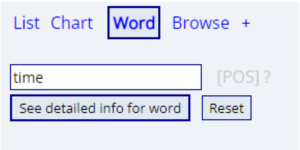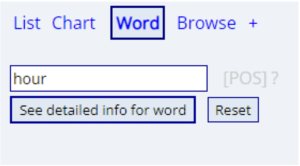12. Talking about time: “time”, “hour”, and “o’clock”
Laura Doleys; Laura Oliveira; and Maria Eduarda do Livramento
Laura Doleys
Undergraduate student at Federal University of Rio Grande do Sul
Laura Oliveira
Undergraduate student at Federal University of Rio Grande do Sul
Maria Eduarda do Livramento
Undergraduate student at Federal University of Rio Grande do Sul
Goals: To help students understand the difference between o’clock, time and hours and to create sentences with these essential terms.
Audience: Beginner learners of English as a second language
Duration: 20 to 30 minutes
INTRODUCTION
Sometimes, talking about time in English can be confusing. Speakers of English as a Second Language often wonder how to tell time, or how to talk about the duration of an event. In our experience as language teachers and learners, we are usually confused by similar expressions, such as time, hour and o’clock because each of these terms seems to be used interchangeably.
In this lesson plan, we investigate the use of these three words using the Corpus of Contemporary American (COCA) English and Linggle. Using examples provided by these two corpora, we hope that students will learn the difference between these terms. An activity will also be used in the end to reinforce the usage of these words. At the end of this task, there will be no doubts about the use of terms related to time in English!
STEP 1: CORPUS ANALYSIS
In the first phase of this lesson, we focus on introducing the differences between time, o’clock, and hour using the features available on COCA and Linggle. For a teacher who would like to reproduce this lesson plan, they could either print the results from the corpus searches and discuss them with their class, or follow the steps outlined below in class with the students.
First, we used COCA to search for the meaning of these words and their use in context. We used the menu word to search for each of the terms. Using the Word feature of COCA allows us to discover the synonyms and collocates for each of these three terms. Then, on the Linggle website, we searched the frequency of each these terms. The findings from Linggle show that the most common time reference words are “applications” and “examples”.
We prepared the paragraphs below as a summary of the findings for teachers who would like to use COCA and Linggle. We took the concordance lines from Linggle. In these concordance lines, we can clearly see in which situation each word or expression should be used, making it possible to understand the difference between these terms.

Figure 1 – COCA Word search for “time”
Time: 1. an instance or single occasion for some event; 2. an indefinite period; 3. a period of time considered as a resource under your control and sufficient to accomplish something.
Examples with time:
- It all happens in infinitesimally small periods of time.
- This is a time when you probably feel very vulnerable.
- Claudio decided that the time had come to end the whole affair.
- No time for reactions.

Figure 2 – COCA Word search for “hour”
Hour: 1. a period of time equal to 1/24th of a day; 2. clock time; 3. a special and memorable period.
Examples with hour:
- Sometimes it will go an hour and a half.
- Research shows children who play up to an hour a day are happier and less hyperactive .
- Revolution is never practical until the hour of revolution strikes.
- We use this hour to really think about what got us to this fight for sobriety.
O’clock: 1. used after a number from one to twelve to say the time when it is exactly that hour; 2. used to refer to a time of day when you usually do or have a particular thing.
Examples with o’clock:
- It’s two o’clock.
- He called me at four o’clock in the morning.
- For many mums, the kids’ bedtime is chocolate o’clock.
- Make sure you’re there by five o’clock.
Based on the concordance lines and the output of COCA, students can try to come up with a definition for time, hour, and o’clock. A suggested answer is
- Time is used to talk about moments involving time, without necessarily being related to clock hours. It’s also used in expressions like “What time is it?”.
- Hour is used to talk about periods of time. It usually collocates with numbers, but it can also be used without numbers in fixed expressions, such as “darkest hour”.
- O’clock, as seen from the examples, is used to talk about the exact time of a moment. When we want to tell someone the exact time, we need to use o’clock (like the first example: It’s two o’clock).
STEP 2: PRACTICE ACTIVITY
For the explanation and the activity, it will not be necessary to print anything because COCA and Linggle are used online. In this example, we used Kahoot to create a game where students have to guess the appropriate word to fill in the gap. Since we know that not all teachers have internet access in their classroom, we also present the Kahoot activity as a fill in the gap task.
Activity #1:
To test what was seen in class in a fun way, we will use Kahoot. We will play a quiz with the students. The activity must be performed in the classroom or in the computer lab with internet access. Students can play the quiz individually or in pairs, but they must use their names to play, so the teacher is able to see the hits and misses of each student.
The quiz has “fill the gap” questions and true or false questions. The student must remember the meaning and when each term should be used. After each question, if there are students who give the wrong answer, the teacher must explain why the other answer is correct. This way, the teacher can work with the difference between the terms in a more didactic way and the students will have no doubts about the subject.
Link to the quiz example: https://kahoot.it/challenge/?quiz-id=56095fc9-5b96-4473-9f4e-f1d94d276bbd&single-player=true
Kahoot Questions
- Complete the gap: At nine ____ he would get up and have his breakfast.
- Hours
- O’clock
- Time
- Is the sentence correct? He said we should come at four hours.
- True
- False
- Complete the gap: We only got a couple more minutes. I think it’s ____ to stop.
- Hours
- O’clock
- Time
- Complete the gap: It took me more than one ____ to do this homework.
- Hours
- O’clock
- Time
- Is this sentence correct? I usually spend two hours in a ministry session.
- True
- False
- Complete the gap: It was ten ____ at night London time, but five ____ earlier by biological clocks.
- Hours, hours
- Hours, times
- O’clock, hours
- O’clock, times
- When someone asks, “What time is it?” we should answer:
- “It’s nine o’clock!”
- “It’s nine hours!”
- Complete the gap: Time’s running pretty short now – three or four ____ at the outside.
- Hours
- O’clock
- Time
Activity #2:
After the end of the quiz, the teacher can propose a second activity, complementing the first one. In this second part, students must create their own quiz to play with their classmates. The quiz must be done in pairs or trios and must contain 5 or 6 questions. The teacher should encourage the student to take examples from COCA to create the new quiz.
Doleys, L., Eduarda do Livramento, M., & Oliveira, L. (2023). Talking about time: “time”, “hour”, and “o’clock”. In L. Goulart & I. Veloso (Eds). Corpora in English Language Teaching: Classroom Activities for Teachers New to Corpus Linguistics. Open Educational Resource. Montclair State University.
